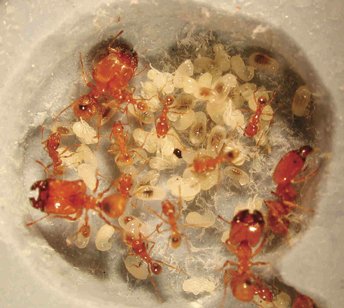Young Ants in the Kitchen
Certain ant larvae fix dinner for adults and don't even sneak snacks as they cook.
By Emily Sohn
Holiday dinners can be a major affair. Someone has to cook the turkey, bake the potatoes, chop and steam the vegetables, stir the soup, mix ingredients for the pie, and more. Then, the chef has to sit down and wait until everyone is served before he or she can start eating.
Some ants go through a similar process of preparing food and patiently waiting to eat—but they do it all year round.
 |
|
Adults with large heads defend the Pheidole spadoniacolony, and the smaller, millimeter-long workers cut up meat from prey and tend the young. The chubby, translucent larvae marinate the meat in their digestive juices before the workers serve it. |
| N. Buck |
Tiny ants of the species Pheidole spadonia love to eat fruit flies (which are four times bigger than the ants). The grown-up ants are as small as the head of a pin, and their waists are so petite that solid food can’t pass through to their tummies.
The young ants (larvae), on the other hand, look like little snowmen that have fallen over on their backs. They do all the kitchen work. The larvae can’t do much more than drool, but powerful chemicals in the liquid turn fruit-fly meat into a baby-food–like pile of moist protein slush.
To find out exactly how the larvae prepare and serve dinner, scientists from Florida and Arizona took videos of Pheidole colonies. What they found was a complicated system of meal preparation and eating etiquette.
When the researchers left a fruit fly for the ants, the grownup workers dragged it into the nest. There, adult workers immediately pulled off and threw away the wings. They took off the head and legs and gave them to the larvae. Then, they divided the fly’s body into chunks, which they placed in hairy indents on top of the larvae’s bellies.
For about 5 hours, the larvae oozed digestive juices onto the meat, dissolving it into a slurpable meal. During the process, adults regularly checked on the stew, taking away liquid that was ready to eat and serving it to the group.
Amazingly, the larvae almost never took a sip themselves until a grownup had collected all the stew. The larvae then took a gulp from the adult’s mouth.
The researchers were able to confirm this by using food coloring to dye some of the fly chunks green. The larvae are almost see-through, so it was possible to see any green bits getting swallowed. It never happened. The larvae ate only from the mouths of adults.
The videos show that larvae play an important role in ant societies, long before they grow up to be working adults. And stewing meat on your stomach is a thankless job, indeed.—E. Sohn
Going Deeper:
Milius, Susan. 2005. Ant iron chefs: Larvae fix dinner but don’t sneak snacks. Science News 168(Dec. 24&31):405. Available at http://www.sciencenews.org/articles/20051224/fob5.asp .
You can find images and information about the ant species Pheidole spadonia at www.tightloop.com/ants/showspecies.php?species_id=36 (Dale Ward).







